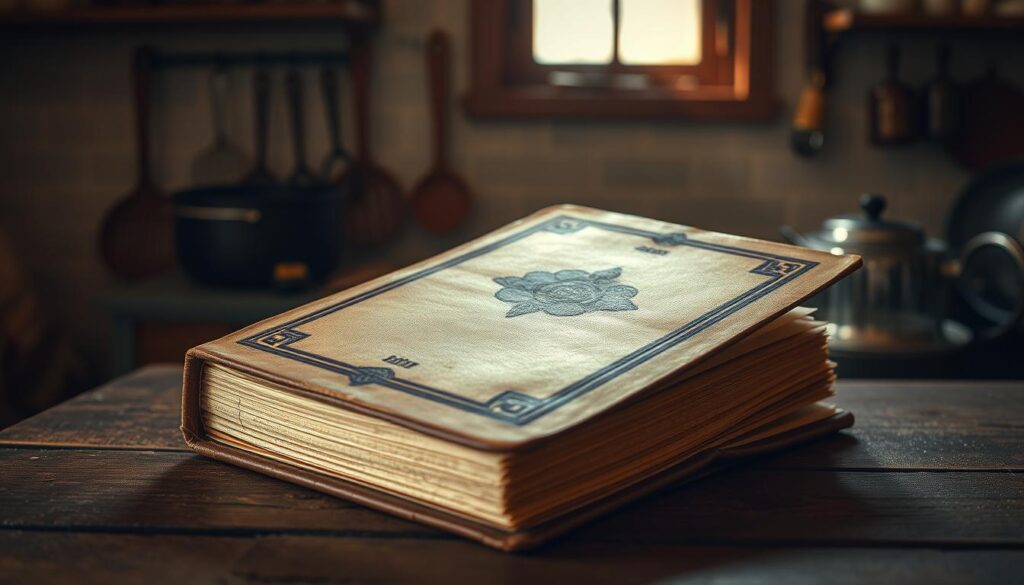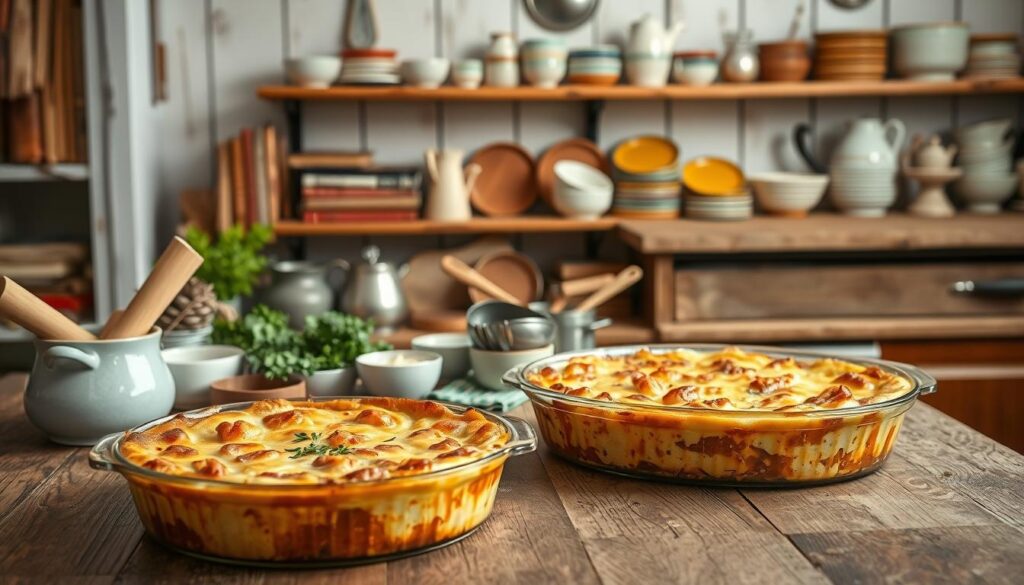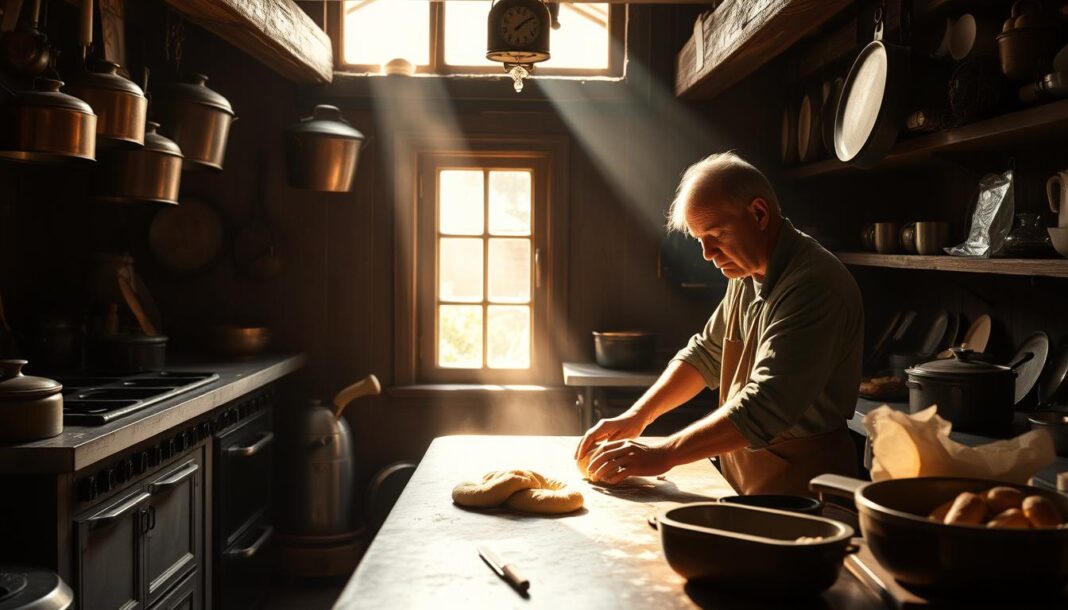We embark on a culinary journey through the ages, revisiting the cherished recipes and cooking techniques that have stood the test of time. In our test kitchen, we’ve researched and tested dozens of vintage recipes to understand their significance and how they can be preserved for future generations.
These classic dishes continue to resonate with modern cooks, despite the changing culinary landscape and our increasingly busy lifestyles. Our exploration reveals not just recipes, but also the wisdom and practical knowledge embedded in traditional cooking techniques.
Key Takeaways
- Understanding the cultural significance of traditional foods and their role in our collective culinary heritage.
- Exploring the reasons behind the enduring appeal of classic recipes.
- Preserving vintage cooking techniques for future generations.
- Gaining insights into the wisdom and practical knowledge embedded in traditional cooking methods.
- Discovering how to adapt timeless recipes to modern cooking.
The Nostalgia of Old Time Food
The nostalgia of old time food is a powerful emotional trigger that transports us back to our childhood kitchens. At Historical Foods, we understand the significance of preserving culinary traditions and the emotional connections they evoke.
Here at Allrecipes, we love a good tried-and-true recipe passed down through the generations. And what better place to find good, old-fashioned recipes than in a retro cookbook? From church and junior league treasures to classics tucked away on grandma’s bookshelf, we’ve compiled 15 of the very best recipe that community members found in vintage cookbooks.
Why We Cherish Vintage Recipes
Vintage recipes are cherished because they evoke a sense of comfort and familiarity. The psychological comfort of familiar flavors and food memories creates a unique form of nostalgia that explains why we cling to these vintage recipes even as culinary trends evolve. This nostalgia is deeply rooted in the emotional connection we have with our family’s culinary history.
The Stories Behind Family Cookbooks
Family cookbooks serve as tangible links to our ancestors, preserving not just recipes but family stories, handwritten notes, and cooking wisdom accumulated over years. These cookbooks are more than just collections of recipe; they are historical documents that tell the story of our family‘s history and cultural heritage.
To illustrate the significance of vintage cookbooks, let’s look at some common characteristics:
| Characteristics | Description | Significance |
|---|---|---|
| Emotional Connection | Evokes memories of home and family gatherings | Creates a sense of nostalgia and belonging |
| Culinary Tradition | Preserves cooking techniques and recipes passed down through generations | Maintains cultural heritage and family identity |
| Historical Significance | Reflects the social, cultural, and economic context of the time | Provides insight into the past and the evolution of cuisine |

Treasures from Grandmother’s Kitchen
Grandmother’s kitchen served as the epicenter of family food traditions, where recipes were perfected over years. It was here that the art of cooking was passed down through generations, with techniques and recipes being refined and cherished.
Church and Community Cookbooks
Church and community cookbooks represent a unique aspect of American culinary culture. These cookbooks, often compiled by community members, contain a collection of tested recipes that have been shared and enjoyed by many. They not only preserve local food traditions but also foster a sense of community among home cooks.
Handwritten Recipe Cards
Handwritten recipe cards, stained with food residue and annotated with personal notes, tell stories that go beyond the ingredients listed. They reveal the history of a dish, including substitutions made over time and special occasions they were served at. Our test kitchen has discovered that these vintage recipes often contain unique techniques or ingredient combinations not found in modern recipes.

- These community-sourced recipes have been perfected through years of practice and informal testing.
- They represent a rich culinary heritage that is worth preserving.
- Our test kitchen has found that these recipes often yield delicious results, thanks to the recipe tweaks made by home cooks over the years.
Classic Comfort Casseroles
In the mid-20th century, casseroles became a backbone of American home cooking, combining pantry staples with budget-friendly proteins. These one-dish meals offered comfort and convenience, making them a staple in many households.
Some beloved casserole recipes include:
- Green Bean Casserole: Created in 1955 by Campbell’s test kitchen, this classic has evolved from its canned soup origins to more sophisticated versions. Our test kitchen upgraded this recipe by using a creamy mushroom sauce with fresh button mushrooms, chicken broth, and whole milk, topped with crispy fried shallots.
- Tuna Noodle Casserole: A perfect marriage of pantry staples and budget-friendly protein, this dish helped families stretch their food dollars during economic challenges.
- Chicken and Rice Bake: This simple yet satisfying meal demonstrates how proper technique and thoughtful seasoning can elevate basic ingredients.
Green Bean Casserole
Our version skips the canned soup mix for a creamy mushroom sauce with fresh button mushrooms and whole milk, taking the dish to the next level.
Tuna Noodle Casserole
This classic casserole represents a resourceful use of pantry staples, making it a budget-friendly option for families.
Chicken and Rice Bake
A straightforward yet flavorful recipe that showcases the importance of technique and seasoning in creating a satisfying meal.

Sunday Dinner Staples
In many households, Sunday dinner is more than just a meal; it’s a ritual that involves elaborate preparations and cherished company. These traditional dinners often feature comforting, home-cooked dishes that have been perfected over generations.
Our test kitchen has found that these Sunday dinner staples often employ cooking techniques that build flavor through browning, deglazing, and slow cooking—methods that remain relevant in modern kitchens. These classic recipes not only satisfy our taste buds but also connect us to our culinary heritage.
Pot Roast with Root Vegetables
A classic comfort dish, pot roast with root vegetables is a staple of Sunday dinners. Chuck roast is braised with turnips, new potatoes, and carrots until it’s rich, tender, and succulent, exemplifying the “low and slow” cooking technique that transforms tough cuts of meat into tender, flavorful meals.
Southern Fried Chicken
Southern fried chicken, with its crispy exterior and juicy interior, demonstrates the technical skill behind seemingly simple dishes that were perfected through generations of practice. This beloved recipe is a testament to the power of traditional cooking methods.
Meatloaf with Brown Sugar Glaze
Meatloaf with brown sugar glaze shows how home cooks creatively combined ground meat with pantry staples to create satisfying meals that stretched protein during lean times. The addition of a brown sugar glaze adds a sweet and tangy dimension to this comforting dish.
Hearty Old Time Soups and Stews
In the realm of old time food, soups and stews stand out as testaments to the resourcefulness of home cooks. These comforting dishes have been a staple in many households, providing a way to transform simple, often leftover ingredients into nourishing meals.
We examine how these one-pot wonders formed the foundation of economical cooking, turning humble ingredients into satisfying dishes that warmed homes and brought families together.
Chicken and Dumplings
Chicken and dumplings is a classic comfort food that marries the simplicity of soup with the heartiness of bread. Our test kitchen has mastered the technique of creating light, fluffy dumplings that cook directly in the flavorful broth, making it a recipe worth revisiting.
Split Pea Soup with Ham
Split pea soup with ham is a testament to how home cooks used every part of an ingredient. The use of ham bones adds a depth of flavor to what would otherwise be a simple legume soup, showcasing the resourcefulness of traditional cooking.
Beef Stew with Potatoes
Beef stew with potatoes is a prime example of building flavor through proper browning and deglazing—fundamental cooking skills that elevate simple ingredients into a rich, satisfying dish.
These traditional soups and stews not only demonstrate the efficiency of one-pot meals but also highlight a cooking philosophy that remains relevant today. By maximizing flavor and minimizing waste, these recipes continue to inspire home cooks.
| Recipe | Key Ingredients | Cooking Technique |
|---|---|---|
| Chicken and Dumplings | Chicken, flour, eggs | Simmering |
| Split Pea Soup with Ham | Split peas, ham bones, vegetables | Browning, simmering |
| Beef Stew with Potatoes | Beef, potatoes, carrots | Browning, deglazing, simmering |
Traditional Side Dishes
Traditional side dishes are the unsung heroes of our culinary heritage. They not only complement our main courses but also showcase the rich flavors and techniques of traditional cooking.
We explore how these classic accompaniments often highlight seasonal produce at its peak, preserving the harvest bounty through simple yet effective cooking methods. Our test kitchen has discovered that these timeless side dishes employ techniques that maximize flavor from straightforward ingredients—a valuable skill for modern home cooks.
Scalloped Potatoes
Scalloped potatoes exemplify the technique of layering flavors through meticulous slicing, arrangement, and the gradual absorption of dairy and seasonings during baking, resulting in a rich, comforting dish. This classic recipe is a staple in many traditional meals.
Creamed Corn
Creamed corn represents a preservation technique that transforms fresh summer corn into a rich, comforting side through the extraction and concentration of natural corn milk. The addition of cream enhances the dish’s flavor and texture.
Southern-Style Butterbeans
butterbeans are a budget-friendly, easy side dish that’s most delicious when cooked with bacon. This traditional recipe showcases how humble legumes become transformed through slow cooking with smoky pork—a flavor-building technique common in Southern cuisine, often perfected in a test kitchen.
The Art of Old Time Food Preservation
Food preservation techniques have been refined over time, blending science and tradition to create delicious and sustainable foods. Our ancestors developed these methods out of necessity, but they evolved into culinary arts that not only extended the shelf life of seasonal produce but also enhanced its flavor. In our test kitchen, we’ve found that these traditional preservation methods are experiencing a renaissance as modern cooks seek connection to food sources and sustainable practices.
One of the key aspects of food preservation is the science behind it. Canning and pickling represent scientific processes that our ancestors understood intuitively, creating safe preserved foods through precise acid balance and proper heat processing. For instance, pickled green beans, as shared by Jani Whitsett, turn out crisp with a wonderful dill flavor, thanks to the red pepper flakes that add a nice punch. This recipe from her grandmother’s cookbook highlights the effectiveness of traditional preservation techniques.
Canning and Pickling
Canning and pickling have been staples in food preservation for centuries. The chemistry behind fermentation creates distinctive flavors in foods like sauerkraut and pickled tomatoes, with beneficial microorganisms transforming vegetables into probiotic-rich foods. By understanding the cooking time and temperature, our ancestors were able to preserve food safely.
Root Cellars and Cold Storage
Root cellars and cold storage demonstrate how our ancestors used natural temperature regulation to preserve root vegetables, apples, and other produce without electricity. This method allowed for the storage of food over long periods, making it possible to enjoy seasonal produce year-round. By controlling the storage time and conditions, people could keep their food fresh for months.
Classic Bread Recipes
Classic bread recipes have been the backbone of home cooking, offering a glimpse into the past. For centuries, bread-making has structured household routines, with daily or weekly baking rituals that brought families together. Our test kitchen has found that understanding the science behind gluten development and fermentation helps modern bakers achieve consistent results with these traditional recipes.
Homemade Vanilla Wafers
Homemade vanilla wafers demonstrate how simple cookies were once made from scratch, using natural vanilla for subtle flavor. This traditional recipe highlights the difference between homemade and commercial versions, showcasing the richness of vanilla flavor in every bite.
Buttermilk Cornbread
Buttermilk cornbread showcases regional variations in technique and ingredients, from sweeter Northern versions to traditional Southern cornbread made without sugar. This classic bread recipe is a staple in many home kitchens, particularly for dinner gatherings.
Dinner Rolls from Scratch
Dinner rolls from scratch represent the technique of proper yeast handling and dough development—skills that were once common knowledge in home kitchens. Mastering this traditional bread recipe requires patience and practice, but yields rewarding results.
Vintage Pies and Cobblers
Vintage pies and cobblers represent a rich culinary heritage that continues to inspire modern bakers. These classic desserts have been a staple in many cultures, offering a variety of flavors and techniques that have been passed down through generations.
Classic Apple Pie
A quintessential dessert, classic apple pie is a testament to the simplicity and elegance of traditional baking. The combination of tender apples and a buttery crust makes it a favorite among many. For a tried-and-true apple pie recipe, consider using a mix of sweet and tart apples.
Peach Cobbler
Peach cobbler is another beloved dessert that showcases the beauty of simple, quality ingredients. With its warm, fruit-filled center and crispy, golden-brown topping, it’s a perfect dish for any occasion.
Custard Pie
Custard pie represents the science behind baking, requiring precise temperature control and timing to achieve a silky texture. Our test kitchen has perfected a recipe that yields a smooth, creamy filling.
By understanding the principles behind these classic desserts, bakers can troubleshoot common issues and create their own variations, ensuring that these vintage pies and cobblers continue to delight families for generations to come.
Old-Fashioned Cakes
Old-fashioned cakes have been a staple in American baking for generations, offering a glimpse into the past with their unique ingredients and techniques. These classic desserts not only tantalize our taste buds but also tell stories of resourcefulness and tradition.
Prune Cake
Prune cake represents a category of fruit-based cakes that utilized dried fruits for moisture and natural sweetness. This traditional recipe showcases the ingenuity of bakers who made the most of available ingredients, creating a deliciously moist cake that’s rich in flavor.
Coca-Cola Cake
Coca-Cola cake is a trusty recipe that’s chocolaty, moist, and infused with the unique flavor of Coca-Cola, complemented by a cream cheese frosting that incorporates even more of the iconic soda. This cake demonstrates how commercial products were creatively incorporated into home baking.
Jam Cake
Jam cake is a delightful example of using preserved fruit to create flavorful layer cakes, often spiced with cinnamon, nutmeg, and cloves. Our test kitchen has found that understanding the role of ingredients in these traditional cakes helps modern bakers adapt them for today’s tastes, often reducing sugar content while maintaining the essence of the original recipe.
| Cake Type | Main Ingredient | Unique Feature |
|---|---|---|
| Prune Cake | Dried Prunes | Moist Texture |
| Coca-Cola Cake | Coca-Cola | Chocolate Flavor with Soda Twist |
| Jam Cake | Preserved Fruit (Jam) | Spiced Flavor |
Traditional Puddings and Custards
The art of making puddings and custards is a timeless tradition that transforms basic ingredients into delightful treats. These comfort desserts have been a staple in many cultures, providing warmth and nourishment to families.
Rice Pudding
Rice pudding is a classic dessert that showcases the technique of slow cooking to extract starch from rice grains, creating a naturally thickened dessert. Using arborio rice and folding in whipped cream adds a lovely lightness to this traditional recipe.
Bread Pudding
Bread pudding is a practical and delicious way to repurpose stale bread, transforming it through custard absorption into a completely new dessert. Varied flavor profiles can be achieved by adding different spices or dried fruits.
Banana Pudding
Banana pudding represents a distinctly American evolution of English trifles, layering custard with cookies and fresh fruit for a dessert that balances creamy, crisp, and soft textures. Our test kitchen has perfected this recipe by understanding the science behind starch gelatinization and egg protein coagulation.
| Dessert | Main Ingredient | Texture |
|---|---|---|
| Rice Pudding | Arborio Rice | Creamy |
| Bread Pudding | Stale Bread | Soft, Custard-like |
| Banana Pudding | Vanilla Wafers, Bananas | Creamy, Crisp, Soft |
Understanding the science behind these traditional desserts helps achieve the perfect texture. Our test kitchen emphasizes the importance of using quality ingredients and techniques like slow cooking and custard absorption to create these beloved desserts.
Forgotten Desserts Worth Reviving
Forgotten desserts are a treasure trove of flavors and techniques that deserve a second chance. We explore how certain desserts fell out of fashion despite their unique flavors and textures, often due to changing tastes or the perception that they’re too complicated to prepare.
Some of these vintage desserts have interesting stories behind them. For instance, tomato aspic represents a category of savory gelatin dishes that were once considered sophisticated but fell from favor as convenience foods changed American palates. “There was a time when you couldn’t find a ladies’ luncheon that didn’t have tomato aspic on the menu, and we think it’s high time to give this retro dish another spin.”
Tomato Aspic
Tomato aspic, a savory dessert made with tomatoes, gelatin, and spices, was a staple at mid-century social gatherings. Our test kitchen has tested this recipe and found that it deserves a revival.
Pineapple Casserole
Pineapple casserole demonstrates the unique sweet-savory combinations that were popular in mid-century cooking, pairing tropical fruit with cheese and crackers in an unexpected way. This casserole recipe is a great example of the creative desserts of the past.
Divinity Candy
Divinity candy showcases the technical skill of sugar cooking and egg white whipping that was once common knowledge among home confectioners but has become a specialized art. This classic candy recipe is a great way to practice your sugar cooking skills.
Our test kitchen has tested these forgotten dessert recipes and found that many deserve a revival, offering unique flavors and textures that stand out in today’s homogenized dessert landscape. By revisiting these vintage recipes, we can rediscover the charm of old-fashioned desserts and bring new ideas to modern baking.
- Rediscover unique flavors and textures from the past.
- Explore vintage dessert recipes that have fallen out of fashion.
- Learn about the stories behind forgotten desserts like tomato aspic and pineapple casserole.
Cooking Techniques of Yesteryear
Classic recipes often rely on simple, time-honored techniques to extract maximum flavor from minimal ingredients. These traditional methods, which require time rather than expensive components, have been passed down through generations.
We’ve identified three key techniques that showcase the effectiveness of old-time cooking methods.
Cast Iron Cooking
Cast iron cooking represents a heat management technique that creates superior browning and even cooking. When properly maintained, cast iron cookware develops natural non-stick properties.
Slow Simmering
Slow simmering demonstrates how gentle heat transforms tough cuts of meat and hard vegetables into tender components of soups, stews, and pot roast over time. This technique is essential for developing deep, complex flavor in a simple meal.
Dutch Oven Baking
Dutch oven baking showcases versatile one-pot cooking that creates even heat distribution. Our test kitchen has found that this technique produces superior results, particularly when used for breads and braises.
Adapting Old Time Recipes for Modern Kitchens
We explore how to bring old time recipes into the modern kitchen, ensuring they retain their original charm while becoming accessible to contemporary home cooks. Some of these recipes have been tweaked to incorporate modern ingredients and techniques, yet they remain true to the spirit of grandma’s cooking.
Substituting Ingredients
Substituting ingredients is often necessary when historical components are no longer available or practical. Understanding the function each ingredient served in the original recipe is crucial. For instance, if a recipe calls for lard, we might substitute it with a combination of butter and vegetable shortening to achieve a similar texture and flavor.
| Original Ingredient | Modern Substitute | Reason |
|---|---|---|
| Lard | Butter + Vegetable Shortening | Similar texture and flavor profile |
| Coal-fired oven | Modern electric oven | Different heat distribution |
Adjusting Cooking Times
Adjusting cooking times is critical when moving from traditional cooking methods to modern appliances. Our test kitchen has found that using modern kitchen equipment like stand mixers and pressure cookers can significantly reduce cooking time while maintaining authentic results. For example, a traditional beef stew recipe that originally took 3 hours to cook on a wood-fired stove can now be cooked in under an hour using a pressure cooker.
By applying these adaptations, we can enjoy traditional recipes with a modern twist, making them suitable for today’s home cooks. Our systematic approach to recipe adaptation preserves the essence of historical dishes, making them accessible and enjoyable for a new generation.
How Old Time Food Connects Generations
Old time food serves as a bridge between generations, connecting us through shared culinary traditions. In the South, these traditions are particularly strong, with food playing a central role in family gatherings and cultural heritage. We explore how these vintage recipes and cooking techniques help bridge the gap between different age groups.
Passing Down Culinary Traditions
Passing down culinary traditions involves more than just sharing recipes; it’s about teaching techniques, timing, and the cultural context that makes a dish truly special. For instance, our test kitchen has observed that even simple recipes like old-fashioned soups can evoke powerful memories when made with love and care, just as they were at home years ago.
Creating New Food Memories
Creating new food memories with traditional recipes allows younger generations to connect with their heritage while adapting these traditions to fit contemporary lifestyles and values. As we continue to cook and share meals together, we maintain a living culinary heritage that honors the past while embracing the present.
Bringing Old Time Food Back to Your Table
With the wealth of traditional recipes and techniques discussed, you’re now ready to start bringing old time food back to your home. We recommend starting with simple classics like vintage recipes such as chicken and dumplings or a basic chocolate cake. Understanding traditional cooking principles can elevate your meals.
Creating a personal collection of family and vintage recipes provides culinary inspiration and a connection to food heritage. Our test kitchen suggests starting with one traditional dish per week, adapting them to suit your family’s needs.


